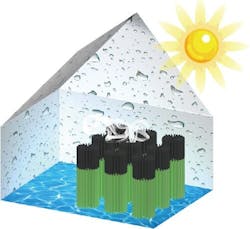Antigravity water transport system is inspired by trees
Phys.org
CHINA, JULY 17, 2019 -- In a new study, researchers have designed a tree-inspired water transport system that uses capillary forces to drive dirty water upward through a hierarchically structured aerogel, where it can then be converted into steam by solar energy to produce fresh, clean water.
The researchers, led by Aiping Liu at Zhejiang Sci-Tech University and Hao Bai at Zhejiang University, have published a paper on the new water transport and solar steam generation method in a recent issue of ACS Nano. In the future, efficient water transport methods have potential applications in water purification and desalination.
The new system consists of two main components: a long, porous, ultralight aerogel to transport water, and a carbon nanotube layer on top of the aerogel to absorb sunlight and turn the water into steam. The system is enclosed in a glass container. Water travels upward through the pores in the aerogel due to capillary forces, which are caused by adhesion between the water molecules and the inner surface of the pores. Once the water reaches the top, the solar-heated carbon nanotube layer heats the water into steam, leaving any contaminants behind. The steam condenses on the sides of the surrounding glass container, forming water droplets that flow down to the bottom of the container into a reservoir for collection.
This design is very similar to the one that plants use. Plants contain many tiny xylem vessels that draw water from the ground up through their branches and leaves—sometimes hundreds of feet in the air. Once the water reaches the leaves, solar radiation causes the water to evaporate through tiny pores in the leaves, similar to the carbon solar steam generator.
Recreating an efficient tree-like water transport system has been challenging, with most previous attempts exhibiting relatively slow transport speeds, short transport distances, and a decrease in performance when transporting sewage and seawater compared to clean water. With the new aerogel design, the researchers demonstrated improvements in all these areas, achieving an upward flow performance of 10 cm in the first 5 minutes and 28 cm after 3 hours. The system also works equally well with clean water, seawater, sewage, and sandy groundwater. In addition, the carbon heat collector achieves a high energy conversion efficiency of up to 85%.
The key to the improvements was the careful design of the aerogel's architecture. To fabricate the material, the researchers poured the aerogel ingredients into a copper tube, which they then subjected to a temperature gradient where the cold end of the tube was a cool –90 degrees Celsius. This caused ice crystals to grow in a pattern within the aerogel along the temperature gradient. After freeze-drying the tube, the resulting aerogel displayed a hierarchical structure with radially aligned channels, micro-sized pores, wrinkled inner surfaces, and molecular meshes. These tiny structures all contributed to the aerogel's good performance.
In the future, the researchers plan to further improve the performance of the system to prepare for applications.
